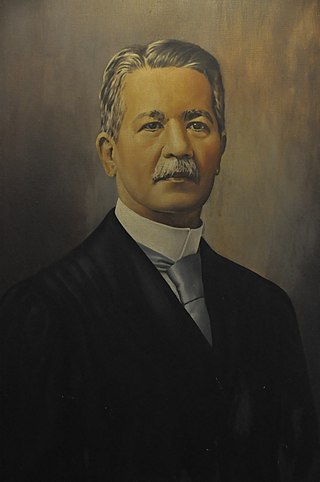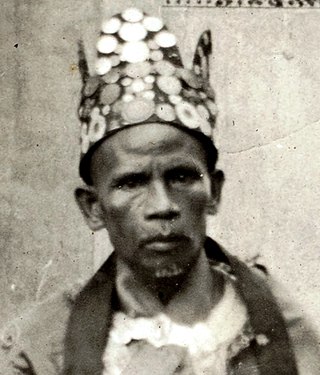
Sulayman, sometimes referred to as Sulayman III, was a Crown Prince of the Kingdom of Luzon in the 16th century and was a nephew of King Ache of Luzon. He was the commander of Luzonian forces in the battle of Manila of 1570 against Spanish forces.
The Pulahan, also known as dios-dios, were the members of a religious revival of Philippine beliefs that developed in the Visayas prior to the Philippine Revolution. At its peak, it numbered around 10,000–15,000 adherents. The movement was severely crippled during the Philippine Revolution after the Philippine Constabulary took over patrols in Samar, when the U.S. military declared the island as "pacified".

Cayetano Simplicio Arellano y Lonzón was the first Chief Justice of the Supreme Court of the Philippines under the American Civil Government. Cayetano Arellano had occupied a high position in Aguinaldo's government. He worked with the Americans under General Otis and re-established the Audiencia Territorial as the Supreme Court. He served as Chief Justice from 1901 until his retirement on April 12, 1920, making him the longest to serve as chief justice in Philippine history.

The Negros Revolution, commemorated and popularly known as the Fifth of November or Negros Day, was a political movement that in 1898 created a government on Negros Island in the Philippines, ending Spanish control of the island and paving the way for a republican government run by the Negrense natives. The newly established Negros Republic lasted for approximately three months. American forces landed on the island unopposed on February 2, 1899, ending the island's independence. Negros was then annexed to the Philippine Islands on 20 April 1901.

Dionisio Magbuelas, Dionisio Seguela or Dionisio Papa y Barlucia, more widely known as Papa Isio, was the leader of a group of babaylanes who were, as conjectured by Modesto P. Sa-onoy, recruited from the remnants of the followers of Dios Buhawi upon the dissolution of his group under the poor leadership of Camartin de la Cruz during the years prior to the onset of the Philippine Revolution.

The Cavite mutiny was an uprising of Filipino military personnel of Fort San Felipe, the Spanish arsenal in Cavite, Philippine Islands on January 20, 1872. Around 200 locally recruited colonial troops and laborers rose up in the belief that it would elevate to a national uprising. The mutiny was unsuccessful, and government soldiers executed many of the participants and began to crack down on a burgeoning Philippines nationalist movement. Many scholars believed that the Cavite mutiny was the beginning of Filipino nationalism that would eventually lead to the Philippine Revolution.

Awit sa Paglikha ng Bagong Pilipinas, also known by its incipit Tindig! Aking Inang Bayan, is a patriotic song written by Filipino composer Felipe Padilla de León. It was commissioned during the Japanese occupation of the Philippines and intended to supplant Lupang Hinirang as the national anthem. It was also sung by the members of the Hukbo ng Bayan Laban sa Hapon, however, the words bear sentiments against the Japanese occupiers and the desire for national liberation.

Mariano Gómes de los Ángeles, often known by his birth name Mariano Gómez y Custodio or Mariano Gomez in modern orthography, was a Filipino Catholic priest who was falsely accused of mutiny by the Spanish colonial authorities in the Philippines in the 19th century. He was placed in a mock trial and summarily executed in Manila along with two other clergymen collectively known as the Gomburza. Gomes was the oldest of the three priests and spent his life writing about abuses against Filipino priests.
Don Juan Macapagal, Datu of Arayat, was the great-grandson and the most eminent descendant of the last ruling Lakan (Emperor) of Tondo, Don Carlos Lacandola. Don Juan Macapagal was given the title Maestre de Campo General of the natives Arayat, Candaba and Apalit for his aid in suppressing the Kapampangan Revolt of 1660. He further aided the Spanish crown in suppressing the Pangasinan Revolt of Don Andres Malong in the same year, and the Ilocano Revolt of 1661. Don Juan Macapagal died in 1683. Don Juan Macapagal is a direct ancestor of Philippine Revolutionary General, Lázaro Macapagal and two former Philippine Presidents Diosdado Macapagal and his daughter, Gloria Macapagal Arroyo.
The Tondo Conspiracy of 1587, popularly known as the Conspiracy of the Maginoos, also known as the Revolt of the Lakans, was a revolt planned by Tagalog nobles known as maginoos, led by Don Agustin de Legazpi of Tondo and his cousin Martin Pangan, to overthrow the Spanish government in the Philippines due to injustices against the Filipinos. It was territorially one of the largest conspiracies against the Spanish rule next to the Katipunan. It ranged from provinces near Manila all the way to the Calamianes Islands near Palawan.
The Negrenses are the native cultural group of the Philippine provinces of Negros Occidental, Negros Oriental and Siquijor.

Dear Friend is a Philippine television drama anthology series broadcast by GMA Network. Hosted by Jolina Magdangal and Marvin Agustin, it premiered on July 20, 2008. The series concluded on May 16, 2010 with a total of 92 episodes. It was replaced by Love Bug in its timeslot.
Datu Magat Salamat was a Filipino historical figure best known for co-organizing the Tondo Conspiracy of 1587. He was one of at least four sons of Lakandula, and thus held the title of Datu under his cousin and co-conspirator Agustin de Legazpi, who had been proclaimed paramount ruler of the indianized kingdom of Tondo after the death of Lakandula, although the position soon became little more than a courtesy title.

Mario Eric Gamalinda is a poet, fiction writer, playwright, and experimental filmmaker.

Convent pornography, convent erotica, friar erotica, priest erotica, monk erotica, or clergy erotica includes paintings, sculpture, photographs, dramatic arts, music and writings that show scenes of erotic or sexual nature involving clergy.

Michael M. Coroza is a Filipino poet, educator, and S.E.A. Write Award laureate.

Saint James the Great Parish Church, commonly known as Bolinao Church, is a Spanish colonial Roman Catholic church located at Brgy. Germinal in Bolinao, Pangasinan, Philippines. It is under the jurisdiction of the Diocese of Alaminos. The church was made out of black coral stones. The church underwent series of natural and man-made calamities, such as the 1788 earthquake, 1819 fire incident, and Typhoon Emong in 2009.
The Premio Zóbel is a Philippine literary award conferred on Filipino writers in the Spanish language. It was established to revivify the Spanish language and to promote the best writing created by Filipino authors in the language. Founded in 1920, it is the only literary prize in Asia that promotes Spanish-language literature, and is also the oldest literary award in the country.

Manuel Villanueva Lopez was a Filipino lawyer and politician. He served as Governor of Negros Occidental from May 9, 1906 to September 25, 1907. He later represented the eighth district at the Senate of the Philippines from October 16, 1916 to June 3, 1919.













